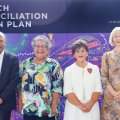Australia is being divided into multiple societies of winners and losers, according to a University of Queensland academic.
"We seem to be at a loss to address the problem," Professor Robert Stimson said. "On current trends, the divisions seem likely to become greater despite our strong national economic performance.
"Perhaps the challenge for the coming decade will be to embrace the concept of a caring society to refocus our concerns to repair some of those divisions."
Professor Stimson is Director of the Australian Housing and Urban Research Institute and a professor of geographical sciences and planning at UQ. He was giving an oration as the Royal Geographical Society of Queensland's 1999 Thomson Medallist for outstanding contributions to the discipline of geography.
Professor Stimson said in his 1992 book The Australian City: A Welfare Geography there were divisions between many sub-groups and between many localities in society. These included complex divisions between "the city" and "the bush." They were between those who were employed and those who were jobless. They were between those with full-time and those with part-time jobs. They were between those with skills that equipped them to participate in the new growth occupations of the information age, and those without such skills or who were in occupations with declining prospects for expansion.
"There is a gender factor in the divisions," he said. "The divisions are between communities that have found a niche in the new global economic order and are expanding, and those that are trapped in an earlier economic ere and are contracting. And the divisions are between those who are part of the political mainstream and those who have been alienated by it."
Professor Stimson said in the 1980s he predicted that the structural difficulties of the Australian economy, the widening (both socially and geographically) of unemployment, the increasing proportion of the population that would be reliant on social-security benefits and on fixed remuneration as the society aged, and the increasing gap between the haves and have-nots would create a political atmosphere where welfare issues in general, and not just in the city, would assume increased significance.
"I was right in predicting the trends, but I was wrong that they would create a political atmosphere where distributional issues would assume increased political significance," he said.
"What happened is that governments in Australia quite enthusiastically embraced economic rationalism. Not too much has been done to plan systematically to address many aspects of socio-economic disadvantage, although unemployment and job creation have become areas where there has been much political rhetoric, but little in-road made to solve the problems."
Professor Stimson's oration highlighted the fact that during the past quarter of a century, the incidence of poverty in Australia has increased from 20 percent to over 30 percent of income units, and that housing related poverty has increased greatly in significance.
The Thomson Medal honours author, surveyor and geographer James Park Thomson CBE (1854-1941), founder of the Queensland branch of the Royal Geographical Society of Australasia.
Previous medal recipients include aviator Bert Hinkler, Antarctic explorer Sir Douglas Mawson, planner and engineer of the Sydney Harbour and Story Bridges Dr John Bradfield, mining engineer and former UQ Chancellor Sir James Foots, and UQ geographer Dr James Skinner.
Royal Geographical Society president Robin Thwaites said of Professor Stimson: "In his contributions to Australian society through urban and regional economic and social analysis; human spatial behaviour and public policy analysis in housing and urban and regional planning, Bob Stimson has used geography as an integrating discipline."
Further information: Professor Stimson, telephone 07 3365 6307



